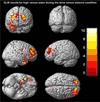A selective review of simulated driving studies: Combining naturalistic and hybrid paradigms, analysis approaches, and future directions
- PMID: 21718791
- PMCID: PMC3197797
- DOI: 10.1016/j.neuroimage.2011.06.037
A selective review of simulated driving studies: Combining naturalistic and hybrid paradigms, analysis approaches, and future directions
Abstract
Naturalistic paradigms such as movie watching or simulated driving that mimic closely real-world complex activities are becoming more widely used in functional magnetic resonance imaging (fMRI) studies both because of their ability to robustly stimulate brain connectivity and the availability of analysis methods which are able to capitalize on connectivity within and among intrinsic brain networks identified both during a task and in resting fMRI data. In this paper we review over a decade of work from our group and others on the use of simulated driving paradigms to study both the healthy brain as well as the effects of acute alcohol administration on functional connectivity during such paradigms. We briefly review our initial work focused on the configuration of the driving simulator and the analysis strategies. We then describe in more detail several recent studies from our group including a hybrid study examining distracted driving and compare resulting data with those from a separate visual oddball task (Fig. 6). The analysis of these data was performed primarily using a combination of group independent component analysis (ICA) and the general linear model (GLM) and in the various studies we highlight novel findings which result from an analysis of either 1) within-network connectivity, 2) inter-network connectivity, also called functional network connectivity, or 3) the degree to which the modulation of the various intrinsic networks were associated with the alcohol administration and the task context. Despite the fact that the behavioral effects of alcohol intoxication are relatively well known, there is still much to discover on how acute alcohol exposure modulates brain function in a selective manner, associated with behavioral alterations. Through the above studies, we have learned more regarding the impact of acute alcohol intoxication on organization of the brain's intrinsic connectivity networks during performance of a complex, real-world cognitive operation. Lessons learned from the above studies have broader applicability to designing ecologically valid, complex, functional MRI cognitive paradigms and incorporating pharmacologic challenges into such studies. Overall, the use of hybrid driving studies is a particularly promising area of neuroscience investigation.
Copyright © 2011. Published by Elsevier Inc.
Figures








Comment in
-
Expanding horizons in ergonomics research.Neuroimage. 2012 Jan 2;59(1):149-53. doi: 10.1016/j.neuroimage.2011.07.060. Epub 2011 Jul 24. Neuroimage. 2012. PMID: 21816226 Free PMC article. No abstract available.
References
-
- Motor vehicle traffic crash fatality counts and estimates of people injured for 2006. Administration NHTS. 2007
-
- Traffic Safety Facts-2007. Administration NHTS. 2008
-
- Ahveninen J, Jaaskelainen IP, Pekkonen E, Hallberg A, Hietanen M, Naatanen R, Sillanaukee P. Global field power of auditory N1 correlates with impaired verbal-memory performance in human alcoholics. Neurosci.Lett. 2000;285(2):131–134. - PubMed
Publication types
MeSH terms
Grants and funding
LinkOut - more resources
Full Text Sources
Miscellaneous

